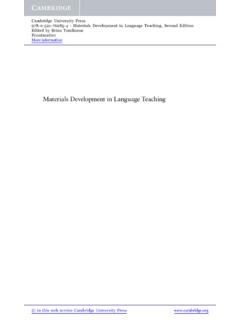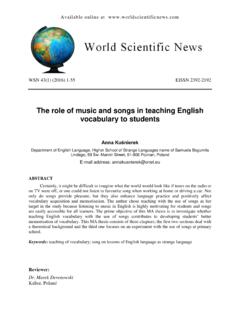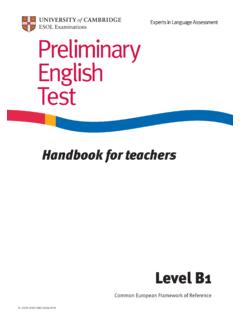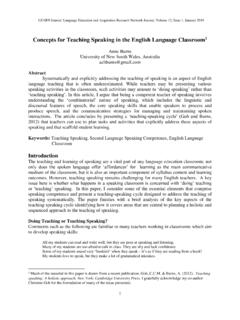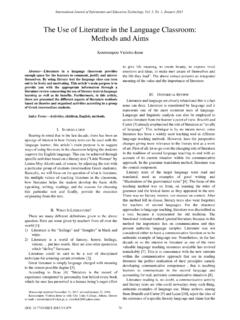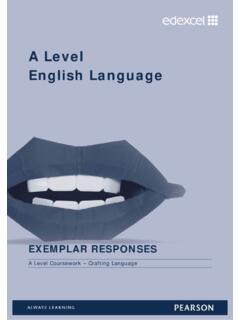Transcription of Non-exam assessment (NEA) sample Language Investigation ...
1 AQA Education (AQA) is a registered charity (number 1073334) and a company limited by guarantee registered in England and Wales (number 3644723). Our registered address is AQA, Devas Street, Manchester M15 6EX. Non-exam assessment (NEA) sample Language Investigation extract A-level english Language 7702 Non-exam assessment : Language in Action 7702/C For teaching from September 2015 For assessment from June 2017 Introduction There are many different approaches to the Language Investigation NEA task and no one-size-fits-all advice to be offered, but this sample Language Investigation extract offers some examples of good practice and commentary on the pros and cons of the approach outlined. With a word count of 2000 for the Language Investigation , it makes sense to advise students not to collect too much data which they will then not be able to explore in any real depth, and rather to be more focused in their data collection.
2 The sample Language Investigation extract shows how a good Investigation can be carried out using a relatively small, but well-selected data set. NEA: Language in Action (7702/C) As detailed in the specification ( ), the aim of this area of study is to allow students to explore and analyse Language data independently and reflect upon their own writing expertise. It requires students to carry out two different kinds of individual research: a Language Investigation (2000 words excluding data) a piece of original writing and commentary (750 words each). Students can choose to pursue a study of spoken, written or multimodal data, or a mixture of text types, demonstrating knowledge in areas of individual interest. This resource focuses specifically on the Language Investigation .
3 AQA Education (AQA) is a registered charity (number 1073334) and a company limited by guarantee registered in England and Wales (number 3644723). Our registered address is AQA, Devas Street, Manchester M15 6EX. 2 of 5 NEA Language Investigation : sample extract Introduction Ever since it first reached our TV screens in 2010, the baking competition the Great British Bake Off has captured the hearts of many people across the nation mine included. As a keen baker myself, I enjoy learning tips from the famous judges, Mary Berry and Paul Hollywood. My Investigation will look specifically at the Language used when Paul and Mary deliver feedback to the contestants in the show. As they are both well-known in the baking world, they have a great deal of expertise, and therefore have a high status on this show.
4 I will look to see how the judges craft their Language to express their opinions, as well as how they represent themselves by what they say; as this is a TV show, I will look to see how they create their individual personas for the audience s benefit. Also, as most TV shows follow the pattern of having both a male and female judge, I will explore whether there are any significant differences in the Language used by males and females. Aims In my Investigation , I hope to explore how power and politeness are shown through the Language used when the judges deliver feedback. I will also look into how gender and power may influence their Language . I will also explore the ways in which the judges employ Language to represent the food they are judging, their own personas and identities and to engage with the contestants.
5 I think that Mary will use more positive politeness as well as more hedging to reduce the impact of any negative feedback, as this would aid the positive representation of herself, as well as demonstrating her expertise. I believe that Paul will use more face-threatening acts in order to demonstrate power. I hope to explore whether the judges particular use of Language is a reflection of gender or personality, and also look at whether they follow the conventions of compliment giving. Methodology I recorded my transcript from an online version of the TV show. I chose the particular episode as it was reaching a tougher stage in the competition; the quarter finals. The judging was more critical and honest compared to other episodes and therefore more linguistically interesting.
6 However, as this is from a TV show, the data may lack validity; the judges may have been performing for the cameras in order to best represent themselves to the audience. I will be using the framework areas semantics and lexis, grammatical constructions and pragmatics. My analysis will mainly be qualitative; focusing on the reasons and meanings of Language use in order to gain an in depth understanding. My linguistic theories will include Politeness and Face Theory and the Difference Model. I will look into the research by Brown and Levinson on Politeness and Face Theory, Deborah Cameron on gender and Language , Deborah Tannen on gender Language differences, and Janet Holmes research into compliment giving. I will also explore whether Mary and Paul being in the same community of practice with the contestants, sharing the mutual engagement of baking, affects the Language they use; the judges sense of hierarchy over the contestants could influence their Language use in terms of demonstrating power and status.
7 (word count 535) Comment [A1]: The introduction is concise and clear, showing the student s own interest in the topic and offering a summary of the main areas being looked at. The gender point at the end is one that might be developed later on with reference to other variables ( age) Comment [A2]: A clear set of aims Comment [A3]: It s not entirely clear why this is expected of them. Comment [A4]: While both are interesting areas, they need a bit more careful explanation at this stage. Comment [A5]: Rationale for data selection offered. Comment [A6]: Some comment on how to deal with this/account for it might help here. Comment [A7]: An interesting range of AO2 Language concepts, research and theory is flagged up here. Comment [A8]: Again, this might be developed a little further.
8 AQA Education (AQA) is a registered charity (number 1073334) and a company limited by guarantee registered in England and Wales (number 3644723). Our registered address is AQA, Devas Street, Manchester M15 6EX. 3 of 5 Transcript The Great British Bake Off, Series 4, Quarter Final Kimberly s Feedback Paul: I think it looks great (.) very detailed which I like anyway (.) and very precise (.) and I will go straight through the middle (3) Mary: it is the texture that you expect from (.) butternut squash (.) pumpkin (1) they re always very moist (.) and but this one s quite close textured (.) but it s good flavour (1) it s a good thing you ve got that icing on it because the actual cake itself is not sweet (1) Paul: no (.) um the filling s good (.) it s the filling that balances it all out (.)
9 It is baked (.) it s full of flavour the spices blend really well in with it as well (1) I think it s been executed perfectly I mean you ve you ve managed to come up with something that looks (1) very good (.) and the bake inside is excellent Frances Feedback Mary: just looking at it (1) there s an element that I m not too happy about and that is that that you ve spent an awful lot of time doing things (.) but the err you haven t made your pots (2) Paul: {cuts into cake} oh right (1) Mary: there s no icing a in it (1) Paul: the middle of that cake the carrot is dry (1) the outside of the cake is quite dense (.) it s moist (.) but you couldn t have any more than a thimble full (.) because it you er err your mouth would just seize up (.) it s it s too (.) bitter (.)
10 It s like eating sometimes when you eat a very rich expensive dark chocolate (.) you can t eat a lot of it you can have a little piece and then you re finished (.) and I think on this occasion (.) erm (.) style and substance may come into play again Ruby s Feedback Mary: I think you ve done some very clever things here I think the caramel (.) praline roof (.) I ve never seen that before (.) and that s what we re always looking for something original (.) Paul: I love the idea of the poppy seed on there (1) I like what you ve done to the top of the cake (.) erm (.) your chocolate work s good as well (2) Mary: I do like the excess of (1) pistachio nuts (.) that really comes through (1) Paul: the bake s good on the cake it s got a great flavour (.) good amount of erm (.)










